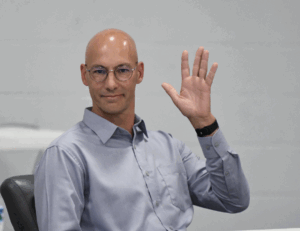
K-5’s return under Plan A highlights eventful BOE meeting
The Wayne County Board of Education has decided to send students in kindergarten through fifth grade back to school under Plan A — full-time face to face — come January.
Board member Jennifer Strickland made the motion at the board’s regular monthly meeting Monday.
She first proposed directing Central Office staff to move forward with making plans to return elementary students to the classroom, but after some confusion about the intent and the exact meaning of her motion and questions about safety, Strickland made a sharp turn and pushed not to seek input, but to make the decision to approve the Plan A return.
The motion, which was approved 5-2 by the board, with members Len Henderson and Pat Burden dissenting, could prove problematic since some fifth-graders are in schools with sixth- through eighth-graders, who are not eligible to participate in the relaxed rules under a Plan A return.
That also means that they are subject to limitations in seating on school buses, in hallways and in common areas — rules that will not apply to the fifth-graders with whom they share a school.
Strickland said that her call for the K-5 return, which is now permitted under revised state directives, is a result of her concern for Wayne County’s youngest students.
“This is about what is best for students of this age,” she said. “They are falling behind.”
That concern was echoed by member Wade Leatham, who said teachers can spot students who need help and who are struggling much more easily in person than “in front of a computer screen.”
Board members all agreed that students needed to be back in the classroom, but several cited safety concerns in the wake of increasing COVID-19 infections locally and statewide.
Chris West, who was re-elected chairman at the beginning of the meeting, said the board has to consider not just the student concerns, but staff worries about their safety as well.
In past discussions about the Plan A return and another proposal to switch high schools to one week on, one week off, administrators told board members that staff were concerned about potential COVID exposure and the challenges that will come meeting staffing guidelines and maintaining quarantine rules.
High schools will be operating under either an AA/BB model — every student attends school in person two days a week — or A/B model — students will go to school every other week — starting in January.
West also pointed out that while the board asked high school principals for their input before they made that change, elementary principals have not been consulted about a move into Plan A.
Strickland responded that the principals could give their input to Central Office staff.
Henderson and new board Tommy Sanders, who was officially sworn in Monday, brought up concerns about increasing COVID numbers and safe operation of schools under Plan A.
“I am really torn,” Henderson said, mentioning that county COVID numbers have been spiking. “We haven’t hit the peak from Thanksgiving yet.”
Sanders said he was also concerned about the increasing numbers, saying that a vaccine was coming and there was “light at the end of the tunnel,” but that he would only be in favor of the Plan A return when the numbers go down.
Sanders later reversed his position based on a report from the district that 65-70 percent of parents who responded to a district survey indicated they wanted to get their children back into the classroom.
But Assistant Superintendent for Teaching and Learning Tamara Berman-Ishee pointed out that parents were asked to choose between hybrid Plan B and all-virtual Plan C — that those who voted for more face-to-face time were doing so based on Plan B and she did not know what would happen when parents are notified that K-5 is returning under Plan A.
Some, she added, might not want to take the risk.
Now that the decision has been made, parents will be asked to decide whether they want their children to return under Plan A or if they want to move to virtual. For planning purposes, non-responses will be counted as a return to face-to-face.
Strickland said now is the perfect time to plan for the Plan A return — that since classes would not officially start until Jan. 11 because the first week of the semester is all remote, there will be time to overcome any infections incurred because of the holiday.
Newly elected Board Vice Chairman Joe Democko asked several questions about the logistics surrounding the Plan A decision, most notably the fifth grade inclusion.
“Sounds to me like we are going to have to move heaven and earth to make some of this happen,” Democko said.
Assistant Superintendent Dr. Tim Harrell said his team needs at least two weeks to get transportation and school lunch plans in place.
And Assistant Superintendent Dr. Marcia Manning said she was very comfortable with the conditions in the schools under the hybrid Plan B and the district has handled the complications associated with COVID-19 well, but added, “we have not been in Plan A.”
Manning said that some parents who are comfortable with Plan B, might have some concerns about Plan A and the looser safety restrictions. Social distancing on school buses and in classrooms is not required under the all face-to-face plan because of feasibility issues.
She added that no matter what happens, district officials will continue to recommend social distancing whenever possible and take cleaning and mask precautions.
Strickland said there might be concerns to work out, but added that moving to Plan A was right for the students.
“I think we can do this,” she said.
Acting Superintendent Dr. James Merrill, who will be leaving the district at the end of December, reminded the board that the problems associated with the Plan A return decision — specifically the transportation of the fifth-graders — could be costly.
“Prior decisions by the board ordered the Central Office to do something and then looked at the cost,” he said. “If it brings an additional cost, I am going to squeal.”
All WCPS families can still opt for their students to be enrolled in the district’s virtual academy.
Also in response to changes necessitated by COVID-19, the board voted to reduce graduation requirements for high school students in the current four-year cohort by two hours.
The move was made to make allowances for students who have been having trouble passing required coursework — core classes — since last March’s COVID shutdown, Berman Ishee said.
Having to retake those classes and managing a schedule have been tough with the need to squeeze in the extra two electives, which is potentially holding up their graduation.
In other business, the board:
• Approved a memorandum of understanding with Seymour Johnson Air Force Base and the county government to discuss putting a school on the base.
Merrill emphasized that at this point, the agreement is only to discuss the possibilities for the proposal, which could include as many as 300 students and would be a 50/50 split between children of military personnel and community members.
While it is just one of the options being considered, preliminary talks have included a technical arts program, Berman Ishee said.
She said the move is a potentially significant opportunity for the district and the students, who could potentially benefit from everything from internship opportunities to foreign language instruction by native speakers.
Merrill said the proposed school opening date is not until August 2022, which means the plans are still in the very early stages.
“This is a wide open discussion,” he said.
• Heard a report from Dr. David Lewis, assistant superintendent for technology and accountability, about next week’s required state testing.
Unlike last spring when all state testing was waived, no such waiver has been approved for this round, Lewis said.
Tests also must be given in a face-to-face environment, which means students will have to come to school, he added.
To deal with the consequences and concerns resulting from that requirement, Lewis said he and school officials are working with everything from enhanced safety protocols to coming up with options for the non-required tests to make more space available to maintain safe distances.
He added that state officials are giving districts more leeway in the deadlines for the testing, which will give schools more time to allow additional safety measures for those who are concerned about coming to the building.
• West and other board members lauded Merrill for his work in the district during his time as interim superintendent and said goodbye to Berman Ishee, who will be stepping down at the end of the month. West said both have made invaluable contributions to the school district.
• The board agreed to bring consulting firm School Operations Specialists, the company hired after Dr. Michael Dunsmore resigned to help fix the district’s budget woes, back to WCPS from January to June.
Merrill said SOS would advise the district two or three days per month for $125/hour or a maximum of $15,000.
“I think it’s a good value for some limited engagement — 15 days over six months,” he said.

A loaded discussion

Fighting for their lives

Goldsboro loses a giant

“I’m a flippin’ hurricane!”
Public Notices — Dec. 14, 2025

Belting it out

Legendary

Final Four!


